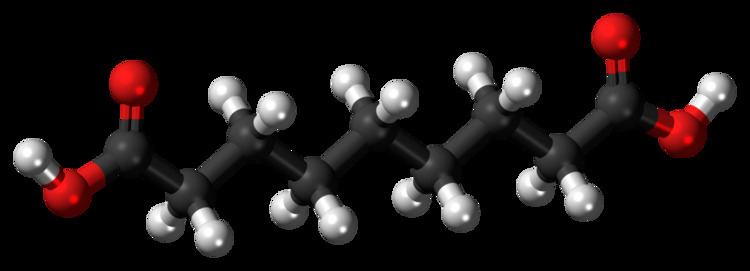Appearance white solid Melting point 109 °C CAS ID 123-99-9 Boiling point 286 °C | Molar mass 188.22 g/mol Formula C9H16O4 IUPAC ID nonanedioic acid Soluble in Water | |
 | ||
Dermatology skin diseases what is azelaic acid
Azelaic acid is an organic compound with the formula HOOC(CH2)7COOH. This saturated dicarboxylic acid exists as a white powder. It is found in wheat, rye, and barley. It is a precursor to diverse industrial products including polymers, plasticizers, as well as being a component of a number of hair and skin conditioners.
Contents
- Dermatology skin diseases what is azelaic acid
- The ordinary review pt 2 retinoid vitamin c lactic azelaic acid rose hip oil
- Production
- Biological function
- Polymers and related materials
- Medical
- Brand names
- References
The ordinary review pt 2 retinoid vitamin c lactic azelaic acid rose hip oil
Production
Azelaic acid is industrially produced by the ozonolysis of oleic acid. The side product is nonanoic acid. It is produced naturally by Malassezia furfur (also known as Pityrosporum ovale), a yeast that lives on normal skin. The bacterial degradation of nonanoic acid gives azelaic acid.
Biological function
In plants, azelaic acid serves as a "distress flare" involved in defense responses after infection. It serves as a signal that induces the accumulation of salicylic acid, an important component of a plant's defensive response.
Polymers and related materials
Esters of this dicarboxylic acid find applications in lubrication and plasticizers. In Lubricant industries it is used as a Thickening agent in Lithium Complex Grease. With hexamethylenediamine, azelaic acid forms Nylon-6,9, which finds specialized uses as a plastic.
Medical
Azelaic acid is used to treat mild to moderate acne, both comedonal acne and inflammatory acne. It belongs to a class of medication called dicarboxylic acids. It works by killing acne bacteria that infect skin pores. It also decreases the production of keratin, which is a natural substance that promotes the growth of acne bacteria. Azelaic acid is also used as a topical gel treatment for rosacea, due to its ability to reduce inflammation. It clears the bumps and swelling caused by Rosacea. The mechanism of action is thought to be through the inhibition of hyperactive protease activity that converts cathelicidin into the antimicrobial skin peptide LL-37. Azelaic acid has been used for treatment of skin pigmentation including melasma and post-inflammatory hyperpigmentation, particularly in those with darker skin types. It has been recommended as an alternative to hydroquinone (HQ). As a tyrosinase inhibitor, azelaic acid reduces synthesis of melanin.
Brand names
Brand names for azelaic acid include Azepur99, Azetec99, Azaclear (azelaic acid and niacinamide), AzClear Action, Azelex, White Action cream, Finacea, Finevin, Melazepam, Skinoren, Ezanic, Azelac, Azaderm, and others.
